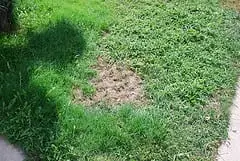Owning a dog is a rewarding experience, but it often comes with challenges that pet parents must navigate. One of the less glamorous side effects of having a four-legged friend is the phenomenon of unsightly brown patches or “burn” spots on your lawn caused by dog urine. This common dilemma can leave dog owners frustrated, particularly when they notice their once vibrant grass turning brown and patchy. Understanding the reasons behind this issue and exploring viable solutions can help maintain both a happy pet and a beautiful yard.
The Science Behind Lawn Burn
The primary culprit behind brown spots on lawns is nitrogen, which is a natural component of dog urine. Dr. Denise Petryk, a veterinarian, explains that the nitrogen content in a dog’s system often correlates with the protein levels in their diet. The more protein a dog consumes, the higher the nitrogen levels excreted in its urine. This unintentional command of lawn devestation can vary among dogs, influenced by factors such as diet, health, and individual metabolic processes, leading to inconsistency in how various dogs affect a lawn.
It is vital for pet owners to understand that while making dietary alterations could reduce nitrogen output, drastic changes to a dog’s diet can have negative health consequences. Lowering protein levels in food is not an advisable solution for the sake of the lawn, as it compromises the overall health of your pet. Therefore, it’s crucial to develop strategies that address both the health of your dog and the vitality of your lawn without taking the “quick fixes” that might harm either.
Instead of dousing lawns with nitrogen-rich fertilizers, which can exacerbate the problem, Dr. Petryk recommends a multifaceted approach to lawn care that promotes resilience to dog urine. This includes monitoring soil pH, establishing a consistent watering schedule, practicing aeration, and choosing the right type of grass for your climate and soil conditions. Certain grass varieties are naturally better suited to withstand the onslaught of nitrogen from dog urine.
A holistic view of yard maintenance can pave the way for a healthy lawn that is less prone to damage. Regularly scheduled watering can dilute the nitrogen concentration on the lawn, a crucial step that must be taken immediately after the dog relieves itself. By implementing these practices, pet parents can foster a more robust lawn that can bounce back from the effects of dog urine more effectively.
Creating a designated toilet area for your dog can drastically change how your lawn is affected. Bryan Kratz from NaturalLawn of America suggests that building a specific zone—covered in gravel or mulch—where your dog is trained to urinate can effectively mitigate lawn damage. This method not only confines the brown spots to one area but also offers a practical solution that keeps the rest of the yard intact.
By employing a leash to guide your dog towards this designated area, pet owners can exert greater control over where their dog urinates, minimizing the spread of brown patches across the lawn. Additionally, encouraging dogs to drink more water can dilute their urination. While techniques such as offering ice cubes or diluted juices may increase water intake, pet owners should be mindful of the increased frequency of restroom breaks indoors.
Natural Remedies and Products
For homeowners looking for chemical-free solutions, there are commercial products like Dog Rocks, which are marketed as natural solutions to the problem of lawn burn. These rocks, derived from a deep Australian quarry, claim to filter out harmful nitrates from a dog’s drinking water, thus potentially reducing the nitrogen output in their urine. Although such products might help ease the situation over time, they do not resolve existing lawn damage.
It is essential for dog owners to remain cautious of any products that promise miracles. Many of these items may not only fail to deliver but could also pose health hazards for pets. As Kratz aptly remarks, the health of dogs should take precedence over any concerns about the lawn’s aesthetic appeal.
When it comes to restoring a lawn that has suffered from dog urine, patience is essential. Contrary to common belief, applying fertilizers or other treatments to the damaged areas will not result in immediate recovery—in fact, they can worsen the damage. Instead, give the grass time to rejuvenate on its own while preventing access to highly hit areas from your dog.
While having a dog undeniably enriches life with companionship and joy, it carries the trade-off of lawn care challenges. Through careful management, strategic training, and responsible dietary practices for dogs, it is possible to enjoy the best of both worlds—happy dogs and healthy lawns.

